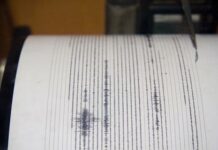Glacial Impact
Antarctica’s glaciers, once contained by a floating ice shelf
along the icy continent’s coast, are now sliding into the sea at an
alarming rate, causing concern that the trend could contribute to
the rise in sea level.
Glacial Impact
Antarctica’s glaciers, once contained by a floating ice shelf along the icy continent’s coast, are now sliding into the sea at an alarming rate, causing concern that the trend could contribute to the rise in sea level.
A joint NASA-University of Colorado team, writing in the journal Geophysical Research Letters, said their satellite observations indicate that glaciers once blocked by the massive Larsen B ice shelf began flowing into the sea up to eight times faster following its break off. When the floating Larsen B shelf separated from Antarctica and broke into thousands of chunks in 2002, there was no discernable rise in the region’s sea level. But the researchers noted immediate water level rises when ice from the continent’s glaciers began entering the ocean.
Ocean Din
The United Kingdom’s Whale and Dolphin Conservation Society (WDCS) launched a campaign to tackle increasing noise pollution, which it says may be seriously harming marine life.
The group warns that undersea noise from oil and gas exploration, and the use of low-frequency military sonars, is causing hearing loss in marine mammals – sometimes killing them. It also believes the manmade din is interfering with the creatures’ ability to communicate with each other.
The International Whaling Commission warned in July that low-frequency marine noise levels had increased in the Northern Hemisphere by two orders of magnitude over the last 60 years. Mark Simmonds of the WDCS told BBC News: “It’s a problem that doesn’t have much noticeable effect on us, unlike chemical pollution, and we can’t see it either.”
Warming Decline
Britain’s moth population is dwindling due to changing habitat caused by global warming, according to a report by England’s Rothamsted agriculture research station.
Each year since 1968, volunteers have systematically catalogued moths collected in light traps across the length and breadth of Britain. Analysis of the samples shows that two-thirds of the moth species have suffered noticeable declines over the past 35 years.
“This is the third warning we’ve had this year. There have been other studies on butterflies and birds and grassland diversity as well, and they’re all showing that something really serious is going on,” said lead research Dr. Kelvin Conrad.
Anthrax Outbreak
Officials in Botswana closed the Chobe National Park to tourists following an outbreak of anthrax, which threatens animals in one of southern Africa’s largest game reserves.
The carcasses of 180 infected buffalo, 10 elephants and one hippo were discovered in the park. Officials said the outbreak poses no threat to humans, but they are worried that carnivores such as vultures, jackals, hyenas and lions may feed on infected dead animals.
Earthquakes
Seismologists were baffled by a magnitude 5.0 tremor that shook the Baltic coast from the Russian outpost of Kaliningrad to neighboring Poland and Lithuania. The quake occurred in an area not known to be seismically active.
• Earth movements were also felt in northern Spain, southern Iran’s Fars province, northern Japan and southeastern parts of Kentucky.
Tropical Cyclones
Hurricane Ivan’s rampage across the eastern United States left at least 44 people dead and many communities still swamped days after it passed. In an unprecedented meteorological event, remnants of Ivan looped southward from off New England to cross Florida and regenerate into a tropical storm over the Gulf of Mexico.
• Authorities in Haiti began digging mass graves for as many as 1,700 victims of massive flooding that was unleashed by Tropical Storm Jeanne. Before strengthening into a hurricane, Jeanne also caused widespread flooding in Puerto Rico.
• Hurricane Karl and Tropical Storm Lisa passed over the open waters of the mid-Atlantic.
• Typhoon Meari was aiming for northern Taiwan and the Chinese mainland late in the week.
Rescue Rats
Earthquake rescue teams may soon be using rats fitted with tiny radio backpacks to help them locate survivors buried beneath rubble, according to a report in the journal New Scientist.
A team from the University of Florida in Gainesville and State University of New York in Brooklyn developed a method to attach miniature transmitters that relay impulses obtained from electrodes implanted in the rodents’ brains.
After training the rats to react to human odor, they can be let loose in an earthquake disaster area to sniff out and locate bodies under the wreckage. The rat’s position can then be determined by triangulating the radio signals.
– By Steve Newman











